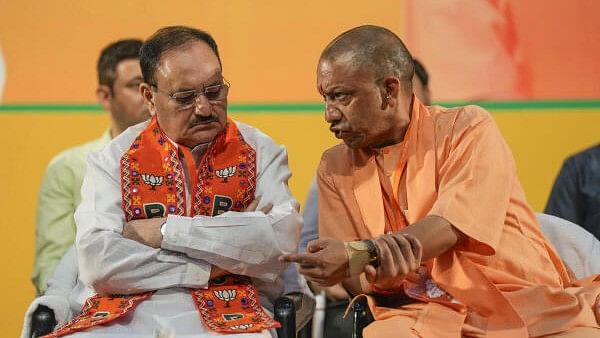
Uttar Pradesh CM Yogi Adityanath (right) with BJP President J P Nadda
Credit: PTI Photo
Before the general elections, Prime Minister Narendra Modi and Uttar Pradesh Chief Minister Yogi Adityanath were positioned as the flawless double-engine team that represented Hindutva, muscular nationalism, and bulldozer raj, and would sweep the polls from Uttar Pradesh. We all know what happened: the decade of single-party rule ended, Modi is now dependent on allies for numbers, and the biggest walloping came from Uttar Pradesh, the site of Modi’s constituency and the Ram mandir, where the Bharatiya Janata Party (BJP) crashed to 33 of 80 seats — a loss of 29 seats and over an 8% drop in vote percentage.
In Uttar Pradesh, not only did Hindutva fail to deliver, but the era of social justice politics also staged a dramatic comeback. Since Modi was the driver for the most emphatic wins for the BJP in the past decade and is still prime minister, it appears that there is no question of him or Home Minister Amit Shah taking any responsibility for the debacle in the state. They did, however, decide the ticket distribution and the chief minister had little say in the matter (he is not even on the parliamentary board, the highest decision-making body of the BJP).
Also, it was the central leadership that pushed the 400-seat campaign (that played into the narrative of constitutional change) and the slogan ‘Modi ki guarantee’ (not the BJP’s guarantee). Had the BJP won handsomely, Modi would have accepted all the applause, but there is to be no acceptance of responsibility for the defeat in Uttar Pradesh. Therefore, an orchestrated campaign has begun to blame Adityanath for the losses in the state. What is interesting is that it’s coming both from within the BJP, and the small caste-based parties from the state that are part of the BJP-led National Democratic Alliance (NDA).
The open critiques are coming from OBC leaders. Minister of State Anupriya Patel, chief of the Apna Dal that represents Kurmis, had fired a clear salvo post-election when she wrote a letter to Adityanath saying that jobs reserved for the Schedule Castes and OBCs were being given to general category applicants. Sanjay Nishad, chief of the NISHAD party, struck at the bulldozer model saying that “uproot the poor and they will uproot us in politics”. UP’s Deputy Chief Minister Keshav Prasad Maurya, seen to be close to Shah, also struck cryptic blows when he said that the organisation is always bigger than the government. The allies were messaging from the caste and social justice perspective of their constituencies of the poor. In criticism from Maurya, who has occasionally been touted as chief ministerial candidate, we see the BJP’s inner positioning.
But Adityanath is no pushover, and should he be asked to vacate his seat, he would say his bit about the BJP high command. He has already said that over-confidence contributed to the poor result (obviously referring to the 400-seat chest thumping). In the Modi era, Adityanath has always remained the sole autonomous chief minister in the BJP.
That said, in Uttar Pradesh’s post-poll scenario, Adityanath has the disadvantage of belonging to the forward Thakur caste. His caste brethren were openly restive during the campaign after a comment about the community by a BJP member from Gujarat. The community also acted in a clannish manner in some seats when their caste brethren did not get the ticket and ensured the defeat of the BJP; Adityanath could not offset Thakur rage in crucial seats such as Muzaffarnagar. Besides, there’s also the optics of having a forward caste leader at the helm when social justice politics is back in Uttar Pradesh. Still, it must be mentioned that the BJP performed better around Gorakhpur, Adityanath’s stronghold than in Varanasi; the party lost many seats around Modi’s constituency, even as his margin of victory plunged in the city.
There would be numerous reasons that led to the BJP’s setback across India. Interestingly, it did particularly poorly in three states where forward caste members are at the helm. The BJP crashed from 25 to 14 seats in Rajasthan where Bhajan Lal Sharma was made chief minister after the assembly polls at the end of last year, while fellow Brahmin Devendra Fadnavis is the most prominent BJP leader in the alliance that did poorly in Maharashtra. Finally, there is Adityanath, who till yesterday was touted as Modi’s successor, today being blamed for the reverses.
What works in Adityanath’s favour, however, is that removing him is conceding that Hindutva has failed — and is not expected to work in the future. Would the Rashtriya Swayamsevak Sangh (RSS) be comfortable with such messaging? Adityanath also has loyalists and a cult following withing BJP voters and has the potential to inflict some damage. Although Thakur voters gave mixed signals, there are many currently posted in police stations across the state. Removing him would certainly be seen as an affront to this forward land-owning caste, which is numerically not as large as OBCs and SCs, but can convert other’s voting choices. Thakurs have also historically been associated with the Samajwadi Party, so they have options.
The larger question is whether the BJP can bounce back from this setback or has the unravelling of the entire project in Uttar Pradesh has begun. The state was not a traditional BJP bastion and was only conquered by the BJP when Modi arrived in 2014. The tide has now turned. We now enter uncharted terrain when things fall apart.
(Saba Naqvi is a journalist and author.)
Disclaimer: The views expressed above are the author's own. They do not necessarily reflect the views of DH.